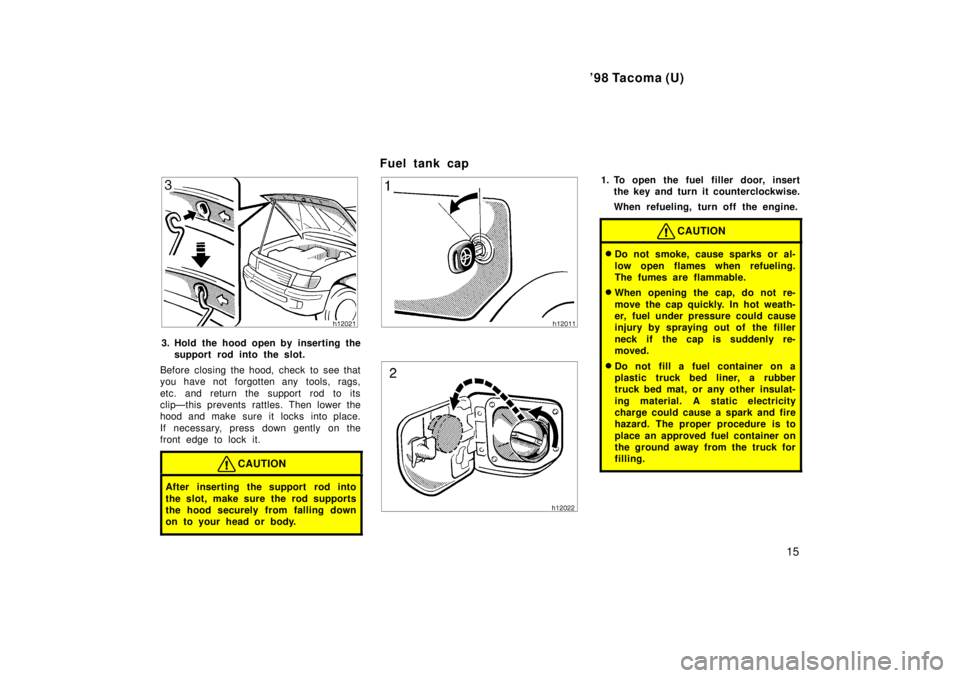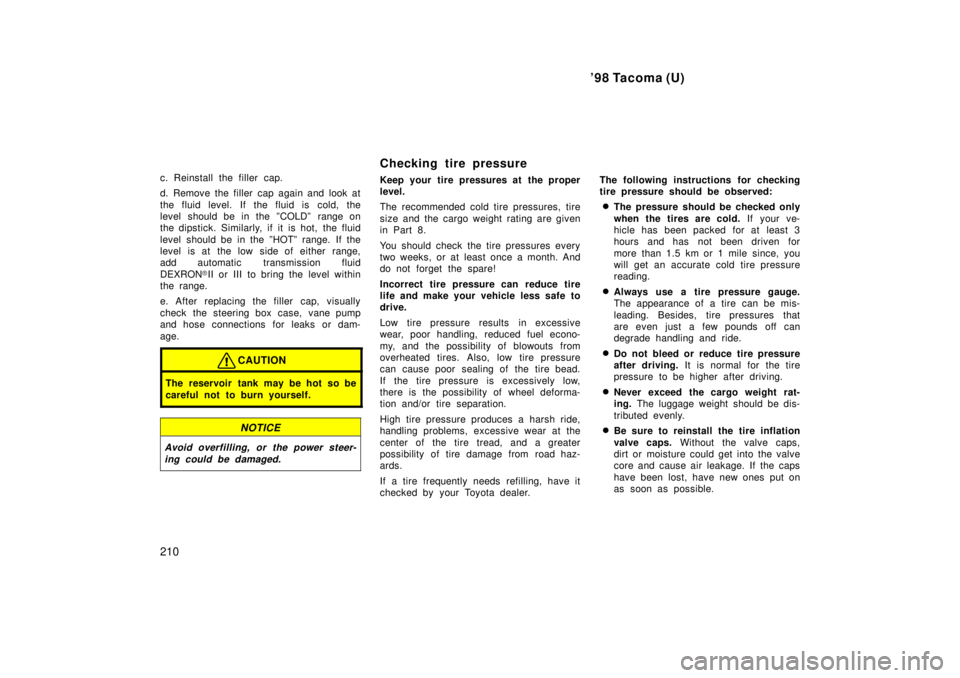fuel pressure TOYOTA TACOMA 1998 Owners Manual
[x] Cancel search | Manufacturer: TOYOTA, Model Year: 1998, Model line: TACOMA, Model: TOYOTA TACOMA 1998Pages: 246, PDF Size: 4.33 MB
Page 6 of 246

'98 Tacoma (U)
6
Indicator symbols on the instrument panel
Automatic transmission fluid temperature warning
light
*
1
SRS airbag warning light *
1
Unengaged ºParkº warning light *
1
Anti-lock brake system warning light *
1
Seat belt reminder light
*
1
(type A)
(type B)
Low oil pressure warning light *
1
Low fuel level warning light *
1
Brake system warning light
*
1
Discharge warning light *
1
Malfunction indicator lamp *
1
Low windshield washer fluid level warning light *
1
Headlight high beam indicator light
Overdrive-off indicator light
Turn signal indicator lights
Driving
pattern
(POWER
mode)
indicator
light
Automatic
transmission
indicator
lights
Four-wheel drive indicator light
Page 15 of 246

'98 Tacoma (U)15
3. Hold the hood open by inserting thesupport rod into the slot.
Before closing the hood, check to see that
you have not forgotten any tools, rags,
etc. and return the support rod to its
clipÐthis prevents rattles. Then lower the
hood and make sure it locks into place.
If necessary, press down gently on the
front edge to lock it.
CAUTION
After inserting the support rod into
the slot, make sure the rod supports
the hood securely from falling down
on to your head or body.
Fuel tank cap
1. To open the fuel filler door, insert the key and turn it counterclockwise.
When refueling, turn off the engine.
CAUTION
�Do not smoke, cause sparks or al-
low open flames when refueling.
The fumes are flammable.
� When opening the cap, do not re-
move the cap quickly. In hot weath-
er, fuel under pressure could cause
injury by spraying out of the filler
neck if the cap is suddenly re-
moved.
� Do not fill a fuel container on a
plastic truck bed liner, a rubber
truck bed mat, or any other insulat-
ing material. A static electricity
charge could cause a spark and fire
hazard. The proper procedure is to
place an approved fuel container on
the ground away from the truck for
filling.
Page 161 of 246

'98 Tacoma (U)161
Getting more kilometers/mileage from a
liter/gallon of fuel is easy±just take it
easy. It will help make your vehicle last
longer, too. Here are some specific tips
on how to save money on both fuel and
repairs:
� Keep your tires inflated at the cor-
rect pressure. Underinflation causes
tire wear and wastes fuel. See Chapter
7- 2 for instructions.
� Do not carry unneeded weight in
your vehicle. Excess weight puts a
heavier load on the engine, causing
greater fuel consumption.
� Avoid lengthy warm-up idling. Once
the engine is running smoothly, begin
drivingÐbut gently. Remember, howev-
er, that on cold winter days this may
take a little longer.
� Accelerate slowly and smoothly.
Avoid jackrabbit starts. Get into high
gear as quickly as possible.
� Avoid long engine idling. If you have
a long wait and you are not in traffic,
it is better to turn off the engine and
start again later. �
Avoid engine lug or overrevving. Use
a gear position suitable for the road on
which you are travelling.
� Avoid continuous speeding up and
slowing down. Stop-and-go driving
wastes fuel.
� Avoid unnecessary stopping and
braking. Maintain a steady pace. Try
to time the traffic signals so you only
need to stop as little as possible or
take advantage of through streets to
avoid traffic lights. Keep a proper dis-
tance from other vehicles to avoid sud-
den braking. This will also reduce wear
on your brakes.
� Avoid heavy traffic or traffic jams
whenever possible.
� Do not rest your foot on the clutch
or brake pedal. This causes needless
wear, overheating and poor fuel econo-
my.
� Maintain a moderate speed on high-ways. The faster you drive, the greater
the fuel consumption. By reducing your
speed, you will cut down on fuel con-
sumption. �
Keep the front wheels in proper
alignment. Avoid hitting the curb and
slow down on rough roads. Improper
alignment not only causes faster tire
wear but also puts an extra load on
the engine, which, in turn, wastes fuel.
� Keep the bottom of your vehicle free
from mud, etc. This not only lessens
weight but also helps prevent corro-
sion.
� Keep your vehicle tuned-up and in top
shape. A dirty air cleaner, improper
valve clearance, dirty plugs, dirty oil
and grease, brakes not adjusted, etc.
all lower engine performance and
contribute to poor fuel economy. For
longer life of all parts and lower
operating costs, keep all maintenance
work on schedule, and if you often
drive under severe conditions, see that
your vehicle receives more frequent
maintenance (For scheduled mainte-
nance information, please refer to the
separate ºOwner 's Manual Supplement/
Maintenance Scheduleº).
How to save fuel and make
your vehicle last longer, too
Page 210 of 246

'98 Tacoma (U)
210
c. Reinstall the filler cap.
d. Remove the filler cap again and look at
the fluid level. If the fluid is cold, the
level should be in the ºCOLDº range on
the dipstick. Similarly, if it is hot, the fluid
level should be in the ºHOTº range. If the
level is at the low side of either range,
add automatic transmission fluid DEXRON
�II or III to bring the level within
the range.
e. After replacing the filler cap, visually
check the steering box case, vane pump
and hose connections for leaks or dam- age.
CAUTION
The reservoir tank may be hot so be
careful not to burn yourself.
NOTICE
Avoid overfilling, or the power steer-
ing could be damaged.
Checking tire pressure
Keep your tire pressures at the proper
level.
The recommended cold tire pressures, tire
size and the cargo weight rating are given
in Part 8.
You should check the tire pressures every
two weeks, or at least once a month. And
do not forget the spare!
Incorrect tire pressure can reduce tire
life and make your vehicle less safe to
drive.
Low tire pressure results in excessive
wear, poor handling, reduced fuel econo-
my, and the possibility of blowouts from
overheated tires. Also, low tire pressure
can cause poor sealing of the tire bead.
If the tire pressure is excessively low,
there is the possibility of w heel deforma-
tion and/or tire separation.
High tire pressure produces a harsh ride,
handling problems, excessive wear at the
center of the tire tread, and a greater
possibility of tire damage from road haz-
ards.
If a tire frequently needs ref illing, have it
checked by your Toyota dealer. The following instructions for checking
tire pressure should be observed:
� The pressure should be checked only
when the tires are cold. If your ve-
hicle has been packed for at least 3
hours and has not been driven for
more than 1.5 km or 1 mile since, you
will get an accurate cold tire pressure
reading.
� Always use a tire pressure gauge.
The appearance of a tire can be mis-
leading. Besides, tire pressures that
are even just a few pounds off can
degrade handling and ride.
� Do not bleed or reduce tire pressure
after driving. It is normal for the tire
pressure to be higher after driving.
� Never exceed the cargo weight rat-
ing. The luggage weight should be dis-
tributed evenly.
� Be sure to reinstall the tire inflation
valve caps. Without the valve caps,
dirt or moisture could get into the valve
core and cause air leakage. If the caps
have been lost, have new ones put on
as soon as possible.
Page 246 of 246

Publication No. OM35729U
Part No. 01999-35729
Printed in Japan 01-9801-00
(U)
Quick index
� If a service reminder indicator or warning buzzer comes on 70 . . . . . . . .
� If your vehicle will not start 164
. . . . . . . . . . . . . . . . . . . . . . . . . . . . . . . . . . . . .
� If your engine stalls while driving 167
. . . . . . . . . . . . . . . . . . . . . . . . . . . . . . . .
� If your vehicle overheats 168
. . . . . . . . . . . . . . . . . . . . . . . . . . . . . . . . . . . . . . . .
� If you have a flat tire 169
. . . . . . . . . . . . . . . . . . . . . . . . . . . . . . . . . . . . . . . . . . .
� If your vehicle needs to be towed 177
. . . . . . . . . . . . . . . . . . . . . . . . . . . . . . .
� Tips for driving during break-in period 138 . . . . . . . . . . . . . . . . . . . . . . . . . . . .
� How to start the engine 151
. . . . . . . . . . . . . . . . . . . . . . . . . . . . . . . . . . . . . . . . .
� General maintenance 193
. . . . . . . . . . . . . . . . . . . . . . . . . . . . . . . . . . . . . . . . . . . .
� Complete index NO TAG
. . . . . . . . . . . . . . . . . . . . . . . . . . . . . . . . . . . . . . . . . . . . .
Gas station information
Fuel type: UNLEADED gasoline, Octane Rating 87 (Research Octane Number 91)
or higher
See page 138 for detailed information.
Fuel tank capacity: Two-wheel drive models except Pre Runner
57 L (15.1 gal., 12.5 lmp. gal.)
Four-wheel drive models and Pre Runner
68 L (18.0 gal., 15.0 lmp. gal.)
Engine oil:
API grade SH, ºEnergy- Conserving IIº or SJ, Energy- Conservingº
multigrade engine oil or ILSAC multigrade engine oil is recommended.
See page 207 for detailed information.
Tire information: See pages 210 through 214.
Tire pressure: See page 232. f
U � 2
I